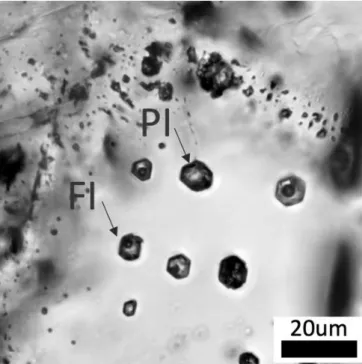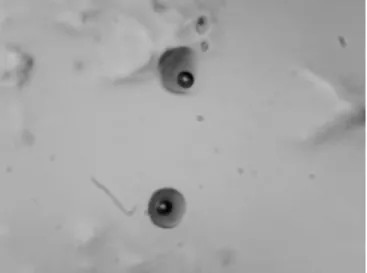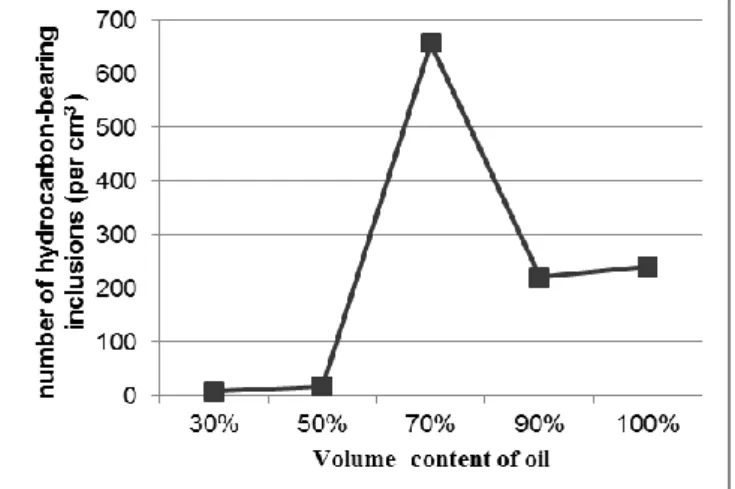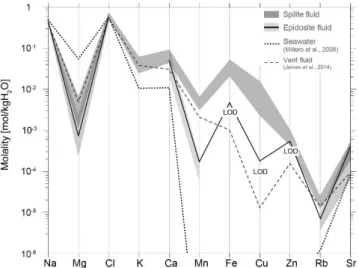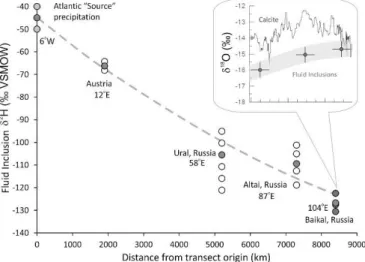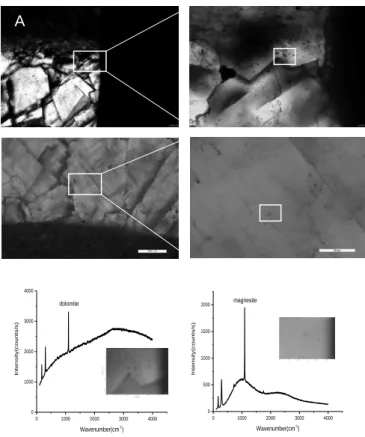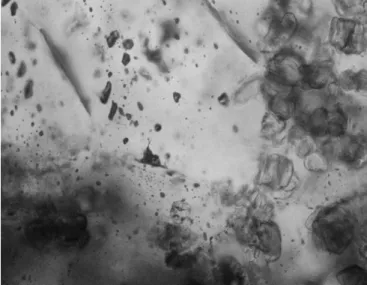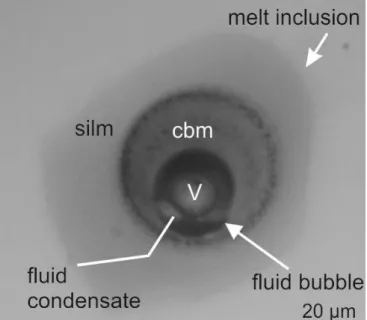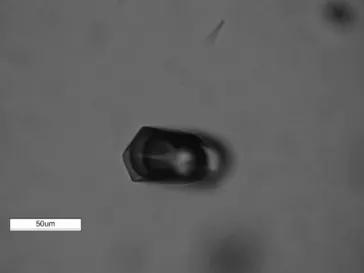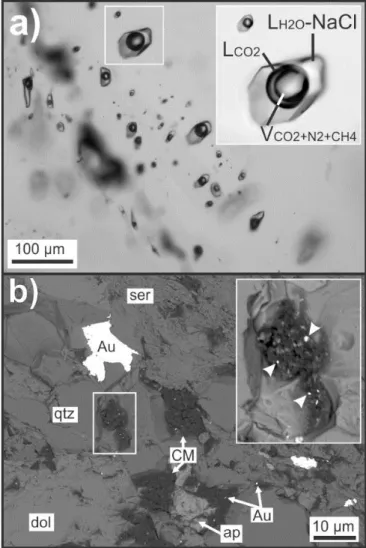ACTA UNIVERSITATIS SZEGEDIENSIS
Volume 10 2019
ACTA
MINERALOGICA-PETROGRAPHICA ABSTRACT SERIES
European Current Research on Fluid Inclusions
ANNO 1998 ELTE
LRG
E C R
F I
2019
A meeting dedicated to fluid and melt inclusions
23-27 June 2019, Budapest, Hungary
thSponsors Guest Editors
Márta Berkesi Tibor Guzmics Gabriella B. Kiss Dóra Cseresznyés
Cover Photo
Apatite-hosted fluid inclusions, Kerimasi, Tanzania Tibor Guzmics
Editor-In-Chief
Elemér Pál-Molnár
University of Szeged, Szeged, Hungary E-mail: palm@geo.u-szeged.hu
Design
Dóra Cseresznyés and Tamás Spránitz
ACTA MINERALOGICA-PETROGRAPHICA established in 1923
ABSTRACT SERIES
HU ISSN 0324-6523 HU ISSN 1589-4835
The Acta Mineralogica-Petrographica Abstract Series is published by the Department of Mineralogy, Geochemistry and Petrology, University of Szeged, Szeged, Hungary
Contributing Editors
Tamás Spránitz Orsolya Gelencsér
Csilla Király Nóra Liptai
LRG
ECROFI XXV
XXVth EUROPEAN CURRENT RESEARCH ON FLUID INCLUSIONS
23-27 June 2019, Budapest, Hungary
ABSTRACTS
Szeged, Hungary 2019
Organising committee
Eötvös Loránd University Budapest, Lithosphere Fluid Reserarch Lab Márta Berkesi, Tibor Guzmics, Csaba Szabó, Anita Csoma (MOL Nyrt.),
Dóra Cseresznyés, Orsolya Gelencsér, Tamás Spránitz, Ábel Szabó, Anita Erőss, Diamond Congress Ltd.
Abstracts were reviewed by
Enikő Bali, University of Iceland, Iceland David Banks, University of Leeds, United Kingdom Zsolt Benkó, Institute for Nuclear Physics, ATOMKI, Hungary
Márta Berkesi, Eötvös Loránd University, Hungary Gulcan Bozkaya, Pamukkale University, Turkey
Andrea Ceriani, University of Science and Technology, United Arab Emirates Anita Csoma, Unconventional Exploration, MOL Group, Hungary György Czuppon, RCAES, Hungarian Academy of Sciences, Hungary
Larryn Diamond, University of Bern, Switzerland András Fall, The University of Texas at Austin, USA
Simona Ferrando, University of Torino, Italy Tibor Guzmics, Eötvös Loránd University, Hungary
Jacob Hanley, Saint Mary’s University, Canada Peter Koděra, Comenius University in Bratislava, Slovakia
Dan Marshall, Simon Fraser University, Canada Jacques Pironon, Université de Lorraine, France Félix Schubert, University of Szeged, Hungary
Alexander Sobolev, Université Grenoble Alpes-CNRS, France Alfons Van den Kerkhof, University of Göttingen, Germany
Editorial Board Editorial Office Manager
Szilvia Csató
Balázs Koroknai György Buda University of Szeged, Szeged, Hungary
Csaba Szabó István Viczián E-mail: csato.szilvia@geo.u-szeged.hu
István Dódony János Földessy
Magdolna Hetényi Péter Árkai
Mihály Pósfai Péter Sipos Editorial Address
Péter Rózsa Sándor Szakáll H-6722 Szeged, Hungary
Szabolcs Harangi Tamás Fancsik 2 Egyetem Street
Tibor Zelenka Tibor Szederkényi E-mail: asviroda@geo.u-szeged.hu
Gábor Papp Tivadar M. Tóth
Preface
It is my great pleasure to welcome all participants of the XXVth ECROFI (European Current Research on Fluid Inclusions) conference in 2019, organized by the Lithosphere Fluid Research Lab for the second time in Budapest, Hungary.
Our main goal during the organization of this meeting was to follow the traditions of the ECROFI by putting the main focus on providing the platform for presenting new results and learning about the latest progress in the analytical, experimental and applied aspects of fluid and melt inclusion research. This goal will be fulfilled by the variable topics of the plenary and poster sessions, as well as the first pre-conference workshop on the 23rd of June, given by Robert J. Bodnar, which is focusing on the basics of fluid inclusion research and their applications.
Secondly, we aim to provide an opportunity to get acquainted with the research environment at the Research and Instrument Core Facility (RICF) related to fluid inclusion studies at Eötvös University, the institute hosting the conference. Therefore, the second workshop will present the laboratories and facilities of the University involved in melt and fluid inclusion research. Finally, our third goal is to introduce the sub-surface fluids beneath the city of Budapest - the greatest thermal water system in Europe - during the post-conference field trip.
Last but not least, we are happy to have the opportunity to support students’ participation by the grant we provide.
For all participants I wholeheartedly wish a professionally successful meeting and a pleasant stay in Budapest!
On behalf of the Organizing Committee,
Márta Berkesi Eötvös Loránd University Lithosphere Fluid Research Lab
ABSTRACTS
Fluid inclusion systematics and mineralogy of the Unique Nictaux Falls Dam Co-Ni-As- Au (±Ag, Bi) occurrence, Meguma Terrane, Nova Scotia, Canada
Adlakha, E.
1*, Kennedy, N.
1, McNeil, N.
1, Hanley, J.
1, Kerr, M.
1& Baldwin, G.
21Department of Geology, Saint Mary’s University, Canada; 2Nova Scotia Department of Energy and Mines, Canada; *erin.adlakha@smu.ca
Polymetallic (Co-Ni-As-Au±Ag,Bi) quartz- sulpharsenide veins of the Nictaux Falls Dam Occurrence are currently being investigated to resolve their formation and the potential for ‘five- elements’ style deposits in Nova Scotia. This showing represents an under-characterised mineralisation style of the Meguma Terrane, Appalachian Orogen, providing an opportunity to study these unique hydrothermal systems.
Two styles of mineralisation occur hosted within fault-bounded quartz veins in late Silurian-aged greenschist Meguma Terrane metasediments: i) laminated, sulpharsenide-quartz veins (Fig. 1A-D) and ii) sulpharsenide mineralised wallrock clasts in quartz breccia (Fig. 1E). Crosscutting relationships with the South Mountain Batholith indicate a maximum age of 370 Ma. The sulpharsenides exhibit unidirectional zoning from Fe-rich (arsenopyrite), to Co-rich (Fe-rich cobaltite), to Ni- rich (Co-rich gersdorffite) rims (Fig. 1B-D).
Compositional (μ-XRF, EPMA-WDS) mapping indicates inherited arsenopyrite from the wallrock (Fig. 1E). Small (<10 μm), Au-Ag alloy grains occur interstitial to Ni-rich rims. Sulpharsenide trace element abundances (LA-ICP-MS) correlate with major element zoning: Fe-rich areas are high in Sb (≤160 ppm) and Bi (≤1600 ppm), and Co-Ni rich areas are high in Au (≤140 ppm), Ag (≤10 ppm) and Se (≤1100 ppm). Based on the solubility of analogous Co-Ni-Fe oxides (Markl et al., 2016) and Se in pyrite (Huston et al., 1995), zoning suggests decreasing pH during mineralisation. Bulk δ34SVPDB
of both types of mineralisation are similar (5.4-6.6
‰ and 3.9-4.6 ‰, respectively) suggesting a well- mixed, homogenised S source. The values overlap with Meguma Group Slates (Kontak and Smith, 1989) suggesting the wall rock as a S source.
Two fluids are preserved in coeval quartz-hosted fluid inclusions (Fig. 1F) in mineralised and barren veins: i) NaCl-H2O±CH4 fluids with salinities of 30 to 35 wt% NaCl equiv. (Th via halite dissolution from 160 to 247 °C; n = 18, with some measurements >
250 °C), and ii) CaCl2-H2O±CH4 fluids with an undetermined but likely high salinity (freezing not observed; Th via vapour out between 136 to 240 °C, n = 34 with some measurements >250 °C).
Estimates of trapping conditions using microthermometric data (c.f. Lecumberri-Sanchez et al., 2012) show that NaCl-rich fluids were trapped at high confining pressure (>2.65 kbar).
Decrepitate salt mound analysis suggests mixing of the two fluids in widely variable proportions as Ca/(Ca+Na) ranges from 0 to 1 (n = 184).
The high fluid salinities combined with a lack of evidence for boiling, low K content and a lack of F in decrepitate mounds preclude a magmatic origin.
Based on fluid P-salinity data and the post- Devonian paleotectonic setting of the study area, we suggest the fluids were marine in origin, likely seawater from the unconformably overlying Carboniferous-aged Maritimes Basin. High Ca may reflect Ca-Na exchange with plagioclase-rich amphibolite facies rocks deeper in the metasedimentary succession. Lack of oscillatory zoning and similar δ34SVPDB in sulpharsenides suggests components were sourced from a single fluid, likely a CaCl2-rich basement fluid that scavengedmetals, S and As from metasediments.
Acknowledgement
Min. Resources Develop. Fund. Government of NS References
Markl G. et al. (2016) Miner. Deposita 51:703-712.
Huston D. et al. (1995) Econ. Geol. 90:1167-1196.
Kontak D.J. and Smith P.K. (1989) Can. J. Earth Sci.
26:1617-1629.
Lecumberri-Sanchez P. et al. (2012) Geochim.
Cosmochim. Ac. 92:14-22.
Fig. 1. A) Laminated quartz-sulpharsenide vein in thin section.
B-D) μ-XRF elemental (Fe-Co-Ni) maps of A. E) A WDS map for Fe in a mineralised wallrock clast in quartz (Qz) breccia Arsenopyrite (Apy) cores are disseminated in net-textured cobaltite (Cbt). E) Clustered fluid inclusions (FI) in quartz interstitial to sulpharsenide (Slf). G) SE image of an evaporite mound.
Impact and conditions of calcite cementation on reservoir quality evolution of Upper Cretaceous limestones, Onshore Abu Dhabi, United Arab Emirates
Alsuwaidi, M.
1*& Ceriani, A.
11Department of Earth Sciences, Khalifa University of Science and Technology, United Arab Emirates;
*Mohammad.alsuwaidi@ku.ac.ae
This petrographic, stable isotopic, fluid inclusion and petrophysical study constrains the conditions of calcite cementation and its impact on reservoir quality of limestones of the Upper Cretaceous Simsima Formation across the anticline of an oilfield, onshore Abu Dhabi, UAE. The various crystal morphologies and occurrence habits of calcite cements and paragenetic relationships among them and with other diagenetic minerals suggest various origins and formation timing.
Scalenohedral and bladed calcite rims around allochems, which are restricted to packstones and grainstones, have precipitated as early cements from marine pore waters. Syntaxial calcite overgrowths around echinoid fragments engulf dolomite cement. Micro-thermometric measurement of fluid inclusions in one sample containing syntaxial calcite overgrowths revealed Th as lower as 64 ºC and salinity of nearly 20.5 wt%
NaCl equivalent corroborate an origin of fluids from a highly evaporative setting.
The precipitation of coarse equant blocky calcite is common in limestones which display ample evidence of dissolution of peloids, which may have acted as source for this cement. An additional cement source is expected to by the incipient stylolitisation of the limestones. The presence of this late equant calcite, which post-dates and replaces moldic pore filling dolomite, both in the oil and water zones may pre-date the oil emplacement. However, in the oil zone these moldic pores have, in many cases, escaped cementation by calcite and were instead filled with oil indicating that oil emplacement retarded or even stopped diagenesis.
The higher δ18OVPDB values of some of the micrite/microspar rich samples than the values expected for marine calcite precipitated at around 25o C were indicate that the waters were enriched in 18O due to evaporation or that precipitation occurred at low temperatures. Conversely, the coarse equant calcite cements have moderate depletion in δ18OVPDB (-6.2 to -3.2‰). Combining these relatively moderately negative oxygen isotopic values with high homogenisation temperatures (76-95 °C) and high fluids salinity (16-19 wt% NaCl) (Fig. 1) suggest precipitation in semi-closed diagenetic systems from geochemically evolved formation waters. The higher homogenisation temperatures than maximum burial temperatures reached suggest that the role of flux of hot basinal brines on diagenesis of the limestones should not be ignored. The formation of secondary pores (e.g.
vugs) might indicate that these brines were charged with organic acids.
Acknowledgement
This presentation is based upon work supported by the Khalifa University of Science and Technology under Award No. [FSU-2018-15].
Fig. 1. Frequency histograms showing salinity data distribution in blocky calcite cement. Solid bars are for samples in the oil ledge and open bars in the water ledge
Comendite and Pantellerite melts of the early Mesozoic bimodal associations of Central Mongolia and mechanisms of their formation
Andreeva, I.
1*1Institute of Geology of Ore Deposits, Petrography, Mineralogy and Geochemistry, Russia; *andreeva@igem.ru We estimated the composition, evolution and
formation conditions of magmas and determined the formation mechanism of melts that produced the comendites and pantellerites of the bimodal volcanic associations of Sant and Dzarta–Khuduk, Central Mongolia, based on electron and ion microprobe analysis of melt inclusions.
Primary melt inclusions were observed in quartz from comendites of the Sant volcanic association, and in quartz from pantellerites of the Dzarta–
Khuduk Massif (Andreeva et al., 2018). The inclusions consist of glass + gas phase ± daughter minerals. In addition to glass and gas phases the melt inclusions in quartz from pantellerites contain a fine-grained salt aggregate consisting of Li, Na and Ca fluorides. The phenocrysts of the comendites crystallised at temperatures of 880–
960 °С. The phenocrysts of the pantellerites crystallised at higher temperatures of 1000–1060
°С. In addition, heating experiments on quartz- hosted melt inclusions from the pantellerites provided evidence for the formation of immiscible silicate and salt (fluoride) melts at a temperature of 800 °С.
The homogeneous glasses of melt inclusions have both trachydacite and rhyolite compositions.
They are characterised by high concentrations of Zr, Nb, Rb, Y, Th and REE. Significant differences were determined in concentrations of Li and volatile component (H2O and F) in the glasses:
some of the melts are enriched in these components, whereas others are depleted in them.
Using the content of Nb as a differentiation index we correlated variations in different trace element content of melts and rocks (from basalts to rhyolites) relative to Nb in order to estimate the role of crystal fractionation during the formation of the rocks of bimodal associations.
There is a clear positive correlation between the contents of Nb and Zr, Nb and Hf in the whole range of compositions of melts and rocks (including their basic varieties). Similar relations with Nb were observed for Rb, Ta, Th, U, Hf, Y, Be, B and REE.
The existence of common trends between melts and rocks of different compositions allowed us to presume a genetic link between basic and acid rocks of the Sant and Dzarta–Khuduk bimodal association.
The glasses of the homogenised melt inclusions from the comendite phenocrysts at Sant are enriched in Li and F. The melts enriched in these elements were found in melt inclusions from pantellerite at Dzarta–Khuduk. The primitive mantle-normalised REE patterns of melt inclusions glasses in phenocrysts of alkalic-salic rocks of both
associations are similar, with the Li maximum being one of the main features.
An extremely important result of studying melt inclusions in phenocrysts from the pantellerites of Dzarta–Khuduk complex was finding Li-enriched fluoride melts along with the silicate melts. This finging suggests the possibility of the generation of a salt melt that extracted significant amounts of Li during the final stages of alkali melt evolution. Such salt melt could subsequently escape from the silicate magma, becoming a source of the rare–
metal mineralisation.
The observed general patterns of melt evolution of the Sant and Dzarta-Khuduk Massifs in the Mongolia-Transbaikalia zoned magmatic area, the comparable ages and rock composition suggest a similar formation mechanisms with a dominant role of a crystal fractionation process. The high alkali and volatile component contents (F and H2O) of the melts resulted in the significant concentrations of many rare elements. During the final stages of differentiation fluoride melts were separated from the silicate magma, extracting considerable amounts of Li.
Acknowledgement
This study was supported by the Russian Foundation for Basic Research, project no. 17–05–00767.
References
Andreeva I.A. et al. (2018) Dokl. Earth Sci. 481:973-979.
Magmatic evolution of Wang-Tian'e volcano (NE China): silicate liquid immiscibility or Fenner-type of crystal fractionation?
Andreeva, O.A.
1*, Andreeva, I.A.
1& Yarmolyuk, V.V.
11Institute of Geology of Ore Deposits, Petrography, Mineralogy, and Geochemistry, Russian Academy of Sciences (IGEM RAS), Russia; *oandreeva@igem.ru
The Changbaishan volcanic area between China and North Korea is the only product of the bimodal magmatism of the Far Eastern part of the Late Cenozoic East Asian Intraplate Volcanic Province.
The largest volcanoes of this area in NE China are Changbaishan Tianchi and Wang-Tian’e. In contrast to the Changbaishan Tianchi association of differentiated alkaline rocks lavas of Wang- Tian’e volcano vary from basalt to basaltic andesite and belong mainly to the tholeiitic series and, less frequently, to the alkaline series. Silicic rocks are rare in the area. The goal of this study is to estimate the crystallisation conditions, composition and evolution path of Wang-Tian’e basaltic melts by studying melt inclusions in plagioclase from tholeiitic basalts.
Plagioclase (An75-80Ab19-24Or0.8-1.3) was the first mineral which crystallised in this system. Melt inclusions in plagioclase contain a plagioclase rim and Fe-rich glass, or fine-grained aggregate of clinopyroxene, Ti-magnetite, ilmenite, apatite and sulphides. The composition of the wide rims incrusting the inclusions changes from the outer to inner part of the inclusion from plagioclase (An46- 56Ab39-47Or4-7) to anorthoclase (An13-13.5Ab43-50Or36- 43). The Fe-rich residual glass and the fine-grained aggregate were analysed by electron microprobe using a 10-µm defocused beam. The compositions of Fe-rich glass and the aggregate were identical and show high FeO content – up to 24 wt%, up to 10 wt% CaO, up to 12 wt% MgO, up to 6 wt% TiO2, up to 2 wt% Al2O3, 1 wt% (Na2O+K2O), 1 wt% P2O5, 0.3-0.4 wt% SO3 98% total at 40-43 wt% SiO2. Two types of silicate globules were identified in these inclusions: Fe-rich and Si-rich. Fe-rich globules contain 21-29 wt% FeO, up to 6 wt% MgO, 2-7 wt%
Al2O3, 2 wt% K2O, 1 wt% CaO and more than 5 wt% H2O at 45-51 wt% SiO2. Si-rich globules contain up to 13.5 wt% Al2O3, 6 wt% K2O, 2.2 wt%
Na2O at 71.5-72 wt% SiO2.
The inclusions were homogenised at temperatures of 1180-1190 °C. During thermometric experiments the silicate globules and all the silicate phases dissolved in the melt.
Sulphide phases occurring occasionally in the fine- grained aggregate produced sulphide globules with a pure FeS composition. After the heating experiments the inclusions were either completely homogenised or contained glass+gas bubbles±sulphide globules. Their composition in general is identical to the rock composition: 10- 12 wt% FeO, 15-16 wt% Al2O3, 3-3.5 wt% TiO2, 4- 4.5 wt% MgO, 3-3.5 wt% Na2O, 1.3-1.5 wt% K2O,
8-9 wt% CaO, 0.6-0.8 wt% P2O5 and 0.3-0.6 wt%
SO3 at 49-51 wt% SiO2.
Two possible paths can be suggested for the evolution of the Wang-Tian’e tholeiitic melts. On one hand, in contrast to Bowen’s reaction series, the evolution might have followed a Fenner-type fractionation, which proposed that the Ab-An-Di system followed a crystal fractionation path controlled by clinopyroxene fractionation and accumulation of FeO in the melt. As plagioclase was the first mineral to crystallise from the tholeiitic melt of Wang-Tian'e volcano it could form large crystals, especially at relatively high water content, as can be seen in the tholeiitic basalts. Plagioclase crystallisation resulted in melt enrichment in FeO and depletion in SiO2, Al2O3 and alkalis, which eventually has led to clinopyroxene crystallisation and Fenner-type fractionation. On the other hand, the presence of Si-rich globules in Fe-rich glasses in the inclusions indicates that low temperature silicate liquid immiscibility could have played a role during tholeiitic melt evolution. This was shown by Roedder (1951) for the quartz-fayalite-leucite system. The formation of hydrous Fe-rich globules in Fe-rich glasses could be attributed to kinetic effects during melt ascent to the surface.
Acknowledgement
This study was supported by the Grant of the President of Russian Federation, proj. MK-2419.2019.5, and the Russian Foundation for Basic Research, proj. 17-05- 00767.
References
Roedder E. (1951) Am. Mineral. 36:282-286.
Unraveling a hydrous alkaline metasomatic agent beneath the Styrian Basin: an inclusion study from mantle xenolith
Aradi, L.E.
1*, Berkesi, M.
1,2& Szabó, Cs.
11Lithosphere Fluid Research Lab, Institute of Geography and Earth Sciences, Eötvös Loránd University, Hungary;
2Lendület Pannon LitH2Oscope Research Group, Geodesic and Geophysical Institute, Research Centre for Astronomy and Earth Sciences, Hungarian Academy of Sciences, Sopron, Hungary; *aradi.laszloelod@ttk.elte.hu
The lithospheric mantle was sampled by Plio- Pleistocene alkali basalts across the Styrian Basin (SB), which brought upper mantle xenoliths to the surface. The SB is the westernmost sub-basin of the Pannonian Basin System, located in the transitional zone between the central Pannonian Basin and the Eastern Alps. The lithospheric mantle beneath the SB overlies a region with a fast seismic anomaly, which was interpreted previously (e.g. Qorbani et al., 2015) as a potential remnant of the detached Penninic slab.
In the SB mantle xenolith suite (Aradi et al., 2017) a group of phlogopite-bearing, amphibole-rich xenoliths was found. These xenoliths could be divided into two subgroups, based on the presence or absence of Cl-rich apatite. Relying on the geochemistry of the amphiboles, these rocks were formed during metasomatism, which could have been caused by infiltration of a volatile-rich alkaline mafic melt. This melt reacted with the mantle peridotite mainly via reactive porous melt flow, causing the transformation of Al-rich spinels, orthopyroxenes and clinopyroxenes into Cr-rich spinels, phlogopite and pargasite. Further from the metasomatic agent, the melt might have fractionated along the mantle column, causing even more enrichment in H2O, CO2 and fluid mobile elements (e.g. U, Cl, P), but depletion in basaltic elements (such as Fe and Ti) and potassium. This fractionation led to the formation of the apatite- bearing subgroup.
In the apatite-free xenoliths several primary melt inclusions were found in the newly formed amphiboles (Fig. 1/A), and secondary melt inclusions in the ortho- and clinopyroxenes. The primary inclusions in the amphiboles are partially crystallised, besides silicate glass and CO2-rich bubble, clinopyroxene daughter phase was recognised. Secondary inclusions of the pyroxenes are glassy and contain a CO2-bearing bubble.
In the apatite-bearing xenoliths primary and pseudosecondary inclusions were found (Aradi et al., 2019; Fig. 1/B). These inclusions, besides the dominating CO2 (>98 mol. %), contain small amount of H2O (<1.2 mol%), N2 (<0.1 mol%) and SO42-. The latter one dissolved in the H2O-rich fluid.
The solid phases of the fluid inclusions in the amphibole consist mostly of different carbonates (magnesite, Na-bearing dawsonite, nahcolite and natrite) and sulphates (anhydrite and Na-bearing thenardite-burkeite). To our best knowledge, such Cl--free, but Na+ and SO42--bearing fluid composition was not described previously in
mantle fluids. Along with the formation of amphiboles, the coexisting fluid phase become enriched in volatiles (C-O-N-S), Na+, HCO3- and SO42-, and then trapped in the amphiboles. Thus, this fluid represents the residual portion of the fractionated volatile-rich alkaline mafic melt (represented by the melt inclusions), which metasomatised the SB subcontinental lithospheric mantle (Aradi et al., 2019).
Acknowledgement
This work was completed in the ELTE Institutional Excellence Program (1783-3/2018/FEKUTSRAT) supported by the Hungarian Ministry of Human Capacities. M. Berkesi was supported by the Bolyai Postdoctoral Fellowship Program.
References
Aradi L. E. et al. (2017) Tectonics 36:2987-3011.
Aradi L. E. et al. (2019) Föld. Közl. 149:35-49.
Qorbani E. et al. (2015) Earth Planet. Sc. Lett. 409:96- 108.
Fig. 1. A) Partially crystallised primary melt inclusions in amphibole. B) Pseudosecondary fluid inclusions in amphibole, occurring along the cleavage planes of the host amphibole. L - liquid; V - vapour; S - solid; GL - glass.
Fluid immiscibility from the suite of hydrothermal deposit Avalos, N.
1& Moncada, D.
1*1Department of Geology, University of Chile, Chile; *dmoncada@ing.uchile.cl During the past half-century, numerous fluid
inclusion studies of hydrothermal precious metals and base metal deposits have been conducted, and much of our understanding of the physical and chemical environment of metal transport and deposition in the environment has evolved from these studies. The gold and base metal deposits at Alhué mining district, Chile, are a classic example of the hydrothermal type ore deposit. The Alhué mining district of the coastal range of central Chile is located approximately 70 km southwest of Santiago and 24 km east of the illustrious municipality Villa Alhué. The mining activity began in the 16th century and continues today in several mines in the district. These deposits form as the result of magma-driven fluid flow in a convecting hydrothermal system, possibly associated with the emplacement of an intermediate composition magma. There still remains considerable debate concerning the source(s) of the fluids (magmatic vs. meteoric), the metals (magma vs. wall rocks) in this important class of ore deposit and the duration of the ore-forming process.
We present a multidisciplinary study that will integrate petrological, geochemical, and structural information with fluid composition to constrain thermodynamic and time conditions and geochemical environment under which the precious and base metals precipitate. There is now a large database of fluid properties in these systems that have shown boiling, mixing of fluids and interaction with wall rock which are all associated with mineralisation in this environment.
Once boiling begins at the ascertained depth, the fluid will usually continue boiling up to the surface.
Thus, the presence of fluid inclusions indicative of boiling in surface outcrops suggests that the base of the boiling zone, and the highest gold grades, are likely to be encountered at depth.
Another innovative aspect of this project will be the study on the effects of the budget of precious metals and/or base metals in the veins that might have been modified during the different events of boiling and structural controls through time. The low salinities observed in most Au-rich and, to a lesser extent, Ag-rich deposits have been put forth as evidence that Au (and Ag) are transported as sulphur complexes rather than chloride complexes.
Another possibility is the interaction between wall rock and fluid, which might contribute to the precipitation of Au in the system. Detailed petrography of samples is necessary to identify individual fluid events, because samples usually contain numerous growth zones and/or planes of inclusions representing fluids of potentially different compositions trapped at different times. In-situ
analyses on individual fluid inclusions and mineral textures will be performed using micro-analytical techniques such as infrared (IR) petrography (for opaque minerals), SEM/EDS/EBSD, laser ablation ICP-MS and carbon and nitrogen isotope ratios of fluid inclusion gases, which can be measured online using a crushing device interfaced to an isotopic ratio mass spectrometre (IRMS). These new data will significantly advance our understanding of the Alhué systems and provide basic natural environment data that may be used to estimate thermodynamic properties of complex aqueous fluids at different temperatures, compositions and pressures.
Acknowledgement
I thank the Yamana Gold Inc. exploration team for sample collection and discussion. CONACYT Initiation 1170210
Superposition of multiple hydrothermal events revealed by coupled SEM-CL and fluid inclusion study in VMS related quartz
B. Kiss, G.
1*& Bendő, Zs.
2,31Department of Mineralogy, Eötvös Loránd University, Hungary; 2 Department of Petrology and Geochemistry, Eötvös Loránd University, Hungary; 3Flame Spray Hungary Ltd., Hungary; *gabriella.b.kiss@ttk.elte.hu
Scanning electron microscopy
cathodoluminescence (SEM-CL) study of quartz crystals became a prevailing research method aiming to better understand complex hydrothermal ore formation processes. In spite of its obvious benefits, case studies are almost exclusively limited to Cu-porphyry and epithermal systems and only a few examples are known from other deposit types (e.g. orogenic gold, MVT or VMS) (see e.g.
Rusk et al., 2004, Frelinger et al., 2015 and the references cited therein). Though several studies point at the possible advantages of SEM CL imaging of quartz in fluid inclusion studies, case studies are scarcely found (e.g. Boiron et al., 1992;
Batkhishig et al., 2005), especially in the field of VMS deposits. In the present study we tried to reveal the complex history of quartz formed during submarine hydrothermal process using coupled SEM-CL and fluid inclusion study of quartz.
The studied samples represent VMS stockwork mineralisation related to Jurassic oceanic stage of the Neotethys. Quartz-sulphide veins are hosted in basalt (in Boccassuolo, Reppia and Monte Loreto), gabbro (in Campegli and Bargone) and peridotite (in Vigonzano) (Northern Apennines, Italy).
Fluid inclusion petrography, microthermometry and Raman spectroscopic study was combined with SEM-CL study of quartz. Three quartz generations were already identified by conventional petrography (early, coarse grained euhedral, followed by medium grained subhedral and late stage fine grained anhedral quartz).
However, SEM-CL imaging has revealed such details, which were not observable by polarising microscopy. A complex evolution history was observed, with superposition of multiple hydrothermal events, forming the different quartz generations. Crystallisation of CL-bright gray early quartz was interrupted by CL-dark quartz micro- fracturing, followed by formation of euhedral growth zones. Interstitial quartz precipitated later, followed by micro-brecciation and 2-3 generations of CL-dark/-bright microfractures.
These observations suggest a dynamically changing hydrothermal system. The appearance of growth zones is related to physico-chemical environmental changes during quartz precipitation (Frelinger et al., 2015), while micro-fracturing and micro-brecciation are the results of multiple hydrothermal events (Rusk et al., 2004).
Study of primary fluid inclusions hosted by quartz is in accordance with the above findings. The L+V(+S) inclusions at every locations were trapped from a homogenous parent liquid, showing
homogenisation temperatures of 90-360 °C.
Though temperature ranges were slightly different at the different study localities, Th trends can be defined. Decreasing Th was observed from early (360-240 °C), through transitional (280-150 °C) to late stage quartz (170-90 °C), as well as from core to rim of single crystals (up to 40 °C temperature drop). Not only temperature, but also compositional variability was observed: salinity of 7.3±0.75 to 3.3±0.45 to NaCl equiv. wt% (with a weak correlation with decreasing Th) and average methane content of 0.22 mol/kg (based on Raman spectroscopy analyses) were found. At one location correlation between methane clathrate formation upon cooling and SEM-CL colour was observed: CL-bright core of quartz crystals contained clathrate forming inclusions, while CL- dark outer zones have not shown that feature.
Detailed SEM-CL study of quartz precludes erroneous fluid inclusion microthermometry analyses, as secondary FI in hidden microfractures can be better avoided and small pieces of early quartz within the late fine grained brecciating quartz can be identified. However, Th and compositional changes within a crystal or a vein can also be better understood.
Our results show, this approach can be successfully used in understanding VMS deposit forming hydrothermal systems, thus complete our earlier knowledge on this field.
Acknowledgement
This research was supported by the Hungarian National Science Fund OTKA PD 112580 (to G. B. Kiss) by NKFIH. SEM-CL analyses was available thanks to KMOP 4.2.1/B-10-2011-0002 program.
References
Batkhishig B. et al. (2005) Resour. Geol. 55:1-8.
Boiron M. C. et al. (1992) Geochim. Cosmochim. Ac.
56:175-185.
Frelinger S. N. et al. (2015) Ore Geol. Rev. 65:840-852.
Rusk B. et al. (2004) 14th International Conference on the Properties of Water and Steam, Kyoto, 296-302.
Apatite, magnetite, and inclusion compositions from the Buena Vista deposit, Nevada (USA): implications for a new genetic model for Kiruna-type deposits
Bain, W.M.
1*, Steele-MacInnis, M.
1, Luo, Y.
1, Pearson, D.G.
1, Mazdab, F.K.
2, Marsh, E.E.
3&
Dufresne, A.
11Univrsity of Alberta, Canada; 2Universityof Alberta, USA; 3US Geologic Survey, USA; *wbain@ualberta.ca Recent studies have proposed hybrid
orthomagmatic-hydrothermal models for Kiruna- type iron-oxide apatite (IOA) deposits in which mineralizing fluids comprise both melts and hydrothermal fluids (Tornos et al., 2017; Simon et al., 2018). These models remain controversial but account for the observation of overlapping magmatic and hydrothermal features in many IOA systems.
The Buena Vista IOA deposit (Pershing County, NV) was previously characterised as an endmember hydrothermal IOA systems related to the intrusion of gabbro into carbonate-bearing sedimentary rocks and the subsequent circulation of a magmatic brines around an igneous heat source (Johnson and Barton, 2000). Here we revisit this interpretation and propose a new model for this system based on chemical analysis of apatite, magnetite, and inclusions hosted in Fe- oxide ores and carbonate dikes which cross cut the Fe-oxide ore body.
Characterisation of primary apatite form Fe-oxide ores and carbonate dikes via SEM-CL, EMPA, and LA-ICP-MS showed that both assemblages have similar major and trace element chemistry showing only slight differences in LREE, HREE, and HFSE content. However, both are overprinted by a secondary generation of apatite that shows a distinctive depletion in most trace elements (particularly LREEs), and is intergrown with monazite, REE-bearing allanite, and thorite. Both primary and secondary apatite from Fe-oxide ores and carbonate dikes show positive Nd values. The compositions of magnetite from Fe-oxide ores was homogenous across individual grains and was relatively rich in Ti and V with variable Al and Si.
Primary and secondary apatite from Fe-oxide ores and carbonate dikes host abundant assemblages of coexisting carbonate melt inclusions and aqueous brines (Fig. 1). The carbonate melt inclusions contain ~10 wt% Fe2O3, as well as quartz, anatase and cristobalite.
Coexisting brine inclusions are rich in Na-K-Ca and have unusual microthermometric behaviour, with final melting temperatures of +7 to +12 C. Analysis of decrepitate mounds and crystalline solids in breached brine inclusions showed that in addition to NaCl, carbonate and sulphate are major components of the aqueous fluid and likely explain the positive last-melting temperatures as representing melting of salt hydrates.
Based on the ubiquitous occurrence of carbonate melt inclusions throughout the Buena Vista deposit, as well as the other geochemical data
described here, we interpret that the Buena Vista system is not a purely hydrothermal system as previously suggested. Rather, we propose a hybrid orthomagmatic-hydrothermal model for this system in which Fe transport is accomplished by the circulation of coexisting carbonate melts and aqueous fluids.
References
Johnson D.A. and Barton M.D. (2000) SEG Guide Book 32:127-144.
Tornos F. et al. (2017) Econ. Geol. 112:1595-1628.
Simon A. et al. (2018) SEG Spec. Pubs. 21:89-114.
Fig. 1. An assemblage of coeval aqueous brine inclusions (FI) and polycrystalline carbonate melt inclusions (PI) hosted in apatite from the Buena Vista deposit.
Compositions of silicate, salt, and aqueous fluid inclusions hosted in unidirectional solidification textures from the Saginaw Hill Porphyry Stock, Arizona
Bain, W.M.
1*, Steele-MacInnis, M.
1& Marsh, E.E.
21University of Alberta, Canada; 2US Geologic Survey, USA; *wbain@ualberta.ca A key process in the formation of porphyry ore
deposits is the exsolution of aqueous hydrothermal fluids from silicate melt and the subsequent circulation of these fluid outward from their source.
This process is characterised by various types of immiscibility between concentrated and dilute fluids. The most commonly recognised types of immiscibility in magmatic-hydrothermal systems are between saline aqueous liquids and vapours, and between these aqueous fluids and the silicate melts that give rise to them. However, several recent studies of fluid inclusions in veins from shallow and intermediate-depth porphyry systems have shown that hypersaline melt inclusions (salt melts) can also coexist with assemblages of vapour rich inclusions and/or silicate melt inclusions which contain an immiscible saline liquid at high temperature (Kodera et al., 2014; Rottier et al., 2016; Mernagh and Mavrogenes, 2019). This has been interpreted as evidence of exsolution of salt melts directly from a silicate melt, although this process is still not well understood.
Here we present petrographic and microthermometric observations as well as LA- ICP-MS data from fluid and melt inclusions hosted in magmatic and hydrothermal quartz associated with unidirectional solidification textures (USTs) in the Saginaw Hill quartz monzonite-latite porphyry stock, Arizona (USA). Quartz UST bands are formed as a result of the episodic accumulation and venting of H2O-rich fluids produced via immiscibility with silicate melt during crystallisation and degassing (London, 2009). As a result, USTs can trap inclusions of both hydrothermal fluid as well as the silicate melt form which it has exsolved. Thus, the distribution and compositions of UST-hosted fluid and melt inclusions provide insights into the nature of fluids generated at the magmatic- hydrothermal transition in this system.
The cores of UST quartz and quartz phenocrysts in aplite bands form Saginaw Hill contain abundant brine-rich silicate melt inclusions (BSM) that coexist with hypersaline inclusions (>50 wt%
NaCleq) and vapour inclusions. At high temperature (>700 C) BSM inclusions contain silicate melt, a yellow globular liquid (hydrous salt melt), and vapour in consistent phase proportions. LA-ICP- MS analysis of BSM and hypersaline inclusions showed high concentrations of Cu, Fe, and Zn indicating that these fluids are involved in metal partitioning and transport in this system. In contrast, the rims of UST quartz and quartz phenocrysts in aplite bands contain assemblages of primarily brine and vapour inclusions with variable base melt concentrations (Fig. 1). Data
from this project provides a better understanding of how hydrothermal fluid compositions evolve during the episodic P-T fluctuations which accompany UST formation.
References
Kodera P. et al. (2014) Geology 42:495-498.
London D. (2009) Can. Min. 47:697-724.
Mernagh T.P. and Mavrogenes J. (2019) Chem. Geol.
508:210-224.
Rottier B. et al. (2016) Chem. Geol. 447:93-116.
Fig. 1. CL image of UST quartz showing hydrothermal (CL- gray) and magmatic quartz (CL-bright, growthzoned)
Fluid inclusions in fluorites from North Hameimet, Tebessa, Algeria Bakelli, A.
1,3*, Sami, L.
2,3, Kolli, O.
1,3, Boutaleb, A.
1,3& Meddane, S.
1,31University of Sciences and Technology Houari Boumediene (FSTGAT/Geology, Algeria); 2University of Mouloud Mammeri Tizi Ouzou (Natural Sciences/Geology, Algeria); Laboratoire de Métallogénie et Magmatisme de l'Algérie (FSTGAT/ Geology, Algeria); *aboulykdane@gmail.com
The Mineralisation of North Hameimet Massif is 1700 m long and 600 m wide and, oriented in NW- SE. It is located 17 km away from Tebessa city.
The sedimentary outcrop of the massif has Triassic and Cretaceous ages and, is characterised by fluorite, barite and galena mineralisation. The Triassic part is consisting of a breccia with dolomite-rich elements, silicified small fragments of eruptive rocks which are carried near to the surface during the ascent of the diapier. Here, two types of mineralisation event can be distinguished:
1) breccia enriched in barite, fluorite and sometimes in galena, its formation is related to the Triassic-cover contact;
2) vein mineralisation outcrops in the eastern part of the massif related to the contact between the Albo-Aptian and the Vraconian.
We have studied primary hydrous fluid inclusions (FI) hosted in fluorite. FIs are two-phase (aqueous liquid + vapour) at room temperature in the non- brownish fluorite. In the brownish fluorite we have additionally recognised primary two-phase (hydrocarbon liquid + vapour, Fig. 1) and three- phase (hydrocarbon liquid + aqueous liquid + vapour) fluid inclusions at room temperature.
Our microthermometry suggested the system H2O-NaCl-CaCl2 for the hydrous FIs. In the same FIs the homogenisation temperatures ranged between 104 and 152 °C, the final ice melting temperatures (Tm) varied between -26 and -23 °C.
The aqueous liquid in the three-phase hydrocarbon inclusions could be characterised by the system H2O-NaCl binary. Here the Tm was determined to be between -21 and -17 °C, which can be corresponded to the salinity from 20 to 25 wt% eq.
NaCl (Bodnar, 1993).
We analysed O, C and S stable isotopes in calcite and galena. The collected data show δ13C = -1 ‰;
δ18O = 17 ‰ and δ34S = from 2.2 to 10 ‰. These are in good accordance with the results on sulphides and sulphurs (Mesloula district, Laouar et al., 2016) originated from Triassic sulphates via thermochemical reduction. The residual sulphate was enriched in 34S, which is reflected in the composition of barite in the residual deposition.
The δ13C values of the calcite minerals, indicate an inorganic carbon origin.
Our observations suggest that there was a highly saline and hot (~150 °C) fluid when the crystallisation of fluoride happened. The fluid might undergone a dilution during evolution. The origin of the mineralisation that replaced the limestone and filled the open spaces was hydrothermal. The hydrothermal event might be related to Diapir
movement resulted from different tectonic events, such as in Ouenza, Mesloula, Essouabaa and Sakièt-Koucha in Tunisia (Sami et al., 2011).
References
Bodnar R. J. (1993) Geochim. Cosmochim. Ac. 57:683- 684.
Laouar R. et al. (2016) J. Afr. Earth Sc. 121:119–135.
Sami L. (2011) Thèse Doct. D’Etat, USTHB (FSTGAT), Alger. Algérie.
Fig. 1. Brownish fluorite-hosted two-phase hydrocarbon inclusions at room-T. North Hameimat, Algeria.
Photomicrograph. The fluid inclusions are 60 µm large.
Fluids in granulitic garnetites: high density CH
4fluids versus H
2O-CO
2bearing cordierites, Khabarny Massif (Ural, Russia)
Bakker, R.J.
1*& Puskarev, E.
21Resource Mineralogy, Department of Applied Geosciences and Geophysics, Montanuniversität Leoben, Austria;
2Institute of Geology and Geochemistry, Ural Branch, Russian Academy of Sciences, Russia;
*bakker@unileoben.ac.at
The Khabarny complex is one of the largest ophiolite allochtones along the western part of the Sakmara Zone (Ural, Russia), and consists of mafic-ultramafic rock, such as mantle peridotites (harzburgite, dunite), gabbroic rock (olivine gabbro, gabbronorite, gabbro), dolerite dike swarm, plagio- granites, in addition to sedimentary-volcanic sequences. The rocks investigated in the present study are garnetites that form a lens and block-like small bodies among two-pyroxene crystalline schists in the north-eastern part of the Khabarny Massif. These rocks are metamorphosed volcano- sedimentary rock at granulitic facies conditions, and consist mainly of almandine-pyrope-rich garnets, Mg-cordierite, quartz and rutile.
Fluid components are characterised in fluid inclusions in quartz, garnet and in large channel sites of the six-membered ring structure of cordierite. The cordierite structure can attain maximally 1 mole fluid species per formula unit. In terms of mass percentage one mole of H2O equals to 2.99 mass%, one mole of CO2 equals 6.99 mass%, and one mole of N2 equals 4.57 mass% in a Mg-rich cordierite. The presence of H2O, CO2, and N2 at channel sites can be visualised and quantified with Raman spectroscopy.
Garnet, quartz and cordierite in the garnetites contain abundant solid and fluid inclusions. Quartz occurs in larger irregular elongated nodules, with a maximum length of a few mm. Quartz also occurs in clusters of about 10 to 20 isolated euhedral crystals (each with 5 to 20 µm in diametre) in the centre of each garnet grain. Locally, these quartz inclusions reveal re-equilibration textures with numerous irregular channels and cracks (max. 10 µm length) extending from the quartz surface into the garnet. Moreover, some of these quartz inclusions are identified by Raman as cristobalite.
Complex fluid inclusions with small entrapped pyrophyllite and siderite crystals, in addition to a fluid mixture of CH4 (79 ± 4 mol%) and N2 (21 ± 4 mol%) are rarely observed within the garnet.
These inclusions are smaller than 3 µm in diametre. In quartz, fluid inclusions are mono- phase at room temperature. Raman spectroscopy reveals the presence of CH4 (>96 mol%), and locally minor amounts of C2H6, N2 and H2S. The inclusions occur mainly in trails that are restricted within single quartz grains. Locally, inclusions with similar properties occur in clusters. The fluid inclusions have a regular and equant shape with diametres varying between 1 and 10 µm. A large part of the fluid inclusions contain graphite in
addition to CH4. This graphite is deposited on the fluid inclusion walls, causing a dark appearance of the entire inclusion. The inclusions are locally attached to aragonite crystals that also precipitated within the trails. The calculated densities (from microthermometric data) of the inclusions vary between are 0.349 to 0.367 g/cm3.
Two types of H2O vibration modes are visualised in cordierite: a Raman band at 3598.1 cm-1 and a relative low shoulder at 3580.5 cm-1 CO2 within the cordierite channels reveals a main Raman band at 1382.2 cm-1 and a minor band at 1269.9 cm-1, corresponding to the Fermi double. The Raman bands of N2 in cordierite channels can be distinguished from atmospheric N2, with centre positions at 2325.5 cm-1 and 2330.1 cm-1, respectively.
The contrast in fluid composition between fluid inclusions and cordierite encourages a discussion about the ability of both environments to preserve its fluid content during the exhumation path of granulites under varying temperature-pressure- redox conditions.
Is the entrapped CH4-rich fluid representative of peak metamorphic conditions of the garnetites?
Isochore reconstruction of CH4-rich fluid inclusions in quartz results in a pressure calculation of 541 to 612 MPa at 800 ˚C. Garnet-cordierite geothermometric calculations reveal slightly higher pressures of 600 to 700 MPa in the temperature range 750-800 ˚C. The peak metamorphic redox conditions of the garnetites are assumed to be highly reduced due to the presences of a CH4-rich fluid with minor amounts of C2H6, H2S and N2. In contrast, the CO2-H2O-N2 rich fluid in cordierite represents a relative oxidised environment, with fluid components that are expected to occur in granulite facies rock.
To be continued...
Proper iso-T
hcurves in the H
2O-NaCl system Bakker, R.J.
1*1Resource Mineralogy, Department of Applied Geosciences and Geophysics, Montanuniversität Leoben, Austria;
*bakker@unileoben.ac.at
The software AqSo_NaCl (Bakker, 2018) can be used to characterise the properties of phases that may exist in the binary H2O-NaCl system up to 1000 ˚C and 500 MPa. The model replaces all available correlation equations and other equations of state that are restricted to narrow temperature, pressure and composition intervals. Liquid-vapour, liquid-solid, and vapour-solid immiscibility fields emerge with increasing salinity at relative high temperatures, and already occur at mass fractions of a few µg per gram, at salinities that cannot be detected by microthermometry. Properties such as density, molar volume, composition, and volume fraction of liquid, vapour, and solid phases in fluid inclusions can be calculated in heating and freezing experiments. Isochores can be calculated within the homogeneous fluid field (all-liquid or all- vapour), within immiscibility fields (coexisting two- phase fields LV, SL, and SV), and along the SLV (solid-liquid-vapour) curve. Iso-Th lines are obtained by modifying the total volume of the fluid inclusions by taking account of the volumetric properties of quartz. In addition, the software AqSo_NaCl may calculate bulk properties of fluid inclusions directly from microthermometric data.
The isochores within the two-phase fields and along the three-phase curve (further indicated with
"sub-isochore") are not isochores in the sense of one homogeneous fluid, but the combination of two or three phases with specific properties and volume fractions that sum up to a constant bulk density and composition. These restrictions can be directly applied to closed-system fluid inclusions at variable temperatures. The isochores and sub- isochores calculated with AqSo_NaCl describe the properties of each individual phase (composition, density, and volume fraction) within fluid inclusions during a heating and freezing experiment.
The interpretation of microthermometric analyses from fluid inclusions that are suspected to contain mainly H2O and NaCl was based on the use of highly simplified fluid models also known as
"correlation" equations, due to lack of comprehensive algorithms that describe the p-T-V- x properties of liquids, vapours and solids of the H2O-NaCl system over the complete range of conditions of interest. Experimental studies of synthetic fluid inclusions were used to develop simplified models that relate experimental trapping conditions to homogenisation temperatures (e.g.
Zhang and Frantz 1987; Bodnar, 1995). These models were used to design the so-called "iso-Th"
lines, i.e. temperature-pressure conditions in the homogeneous fluid field (liquid) that result in the same homogenisation conditions (LV→L), without
any knowledge about density. These iso-Th lines are per definition linear, and they are derived from a best-fit to at least two p-T data points (i.e.
homogenisation and experimental conditions).
However, these iso-Th lines may be highly inaccurate at conditions between the two points or at extrapolated conditions. Moreover, the uncertainty of these lines has not been quantified.
The equation of state that describes the variability of the molar volume of quartz (e.g.
Hosieni et al., 1985) can be used to calculate the modification of the fluid density in fluid inclusions in quartz with the software AqSo_NaCl. These modified isochores correspond to true iso-Th lines in fluid inclusion studies, and appear to have highly variable slopes in p-T diagrams.
True iso-Th curves are significantly curved in the liquid-solid field (i.e. brine and halite) and in the homogeneous liquid field. Iso-Th curves are not steeper in the liquid-solid field than in the homogeneous liquid field. The slope of iso-Th
curves in the homogeneous liquid field change significantly at the α-β transition of quartz and may be negative in a small temperature interval close to this transition.
The software AqSo_NaCl can be downloaded from the website of Ronald J. Bakker at the University of Leoben (http://fluids.unileoben.ac.at) and from the supplementary data related to the publication in Computer and Geosciences (Bakker, 2018).
References
Bakker R.J. (2018) Comp. Geosci. 115:122-133.
Bodnar R.J. (1995) Pure Appl. Chem. 67:873-880.
Hosieni et al. (1985) Am. Mineral. 70:782-793.
Zhang and Frantz (1987) Chem. Geol. 64:335-350.
Fluid inclusion study in quartz vein of the Kekura gold deposit, Western Chukchi Peninsula, Russia
Baksheev, I.A.
1, Nagornaya, E.V.
2,1*, Komarova, M.M.
3, Khabibullina, Y.N.
1& Kalko, I.A.
11Faculty of Geology, Lomonosov Moscow State University, Russia; 2Vernadsky Institute of Geochemistry and Analytical Chemistry of Russian Academy of Sciences, Russia; 3Institute of Geology of Ore Deposits, Petrography, Mineralogy and Geochemistry RAS (IGEM RAS), Russia; *chp312@gmail.com
Kekura is the largest gold deposit in the Stadukhino gold district located 50 km south away from Bilibino, Western Chukchi Peninsula, Russia.
It is spatially related to the shallowly eroded Late Cretaceous granodiorite pluton that intrudes Lower Triassic deformed terrigenous sequence enriched in organic matter. Gold-bearing quartz veins and lenses occur within the pluton and near-contact country rocks. Three types of alteration were recognised at the deposit: propylitic, dolomite- quartz-sericite and argillic. Greenish fine-grained propylite is composed of quartz, oligoclase, actinolite, clinochlore, and carbonate. The most abundant whitish dolomite-quartz-sericite rock is altered and contains relict biotite, K-Na feldspar, oligoclase, newly formed muscovite, dolomite and quartz. This alteration is occasionally cut by veinlets with tourmaline, which in turn are cut by carbonate veinlets. Carbonate pods are found in the altered rock. Relict REE phosphates, apatite, and rutile are accessory minerals. The presence of argillic alteration is marked by illite that replaces muscovite in dolomite-quartz-sericite rock.
Fluid inclusions (FI) were identified in quartz (1) isolated or clustered inclusions in the crystal core;
in some samples these inclusions are distributed in the growth zones; and (2) misoriented isolated inclusions or inclusion groups healing fractures crossing several grains. According to the criteria of Roedder (1984), the type 1 and 2 FI were attributed to the primary and secondary, respectively.
Primary fluid inclusions are negative crystal shaped and ranging from 2 to 10 μm and their clusters. Secondary inclusions of 2 to 20 μm in size are more frequent than primary inclusions.
Secondary fluid inclusions are divided into two subtypes: (1) contain liquid CO2 and (2) liquid CO2- free.
Microthermometric study has been carried out on both primary and secondary fluid inclusions. The studied FI homogenised into liquid at 120–300 °C;
final ice melting temperature ranges from -7.0 to - 1.8 °C; fluid salinity varies from 3.1 to 10.5 wt%
NaCl equiv. On the basis of eutectic temperature ranging from -35 to -21 °С, fluid is dominated by Na- and Mg-chlorides. Based on homogenisation temperatures, primary FI could be divided into three groups: 120–180, 220–270, and 300–310 °C.
Homogenisation temperatures of primary FIs observed in a single quartz crystal decrease from 220–230 °C to 120–140 °C from the core to the rim.
Vein quartz from the Kekura deposit is frequently cut by later quartz veinlets. The homogenisation
temperatures measured in the later quartz veinlets range in 130–140 °C and fall into the first group of temperature range.
These observations show that the first temperature range is related to the crystal rims or later thin veinlets. The second range is related to the crystal cores, and the third range is possibly related to the earliest quartz generation.
We have determined homogenisation temperatures of primary FI in quartz vein along an 800 m long bore hole. The homogenisation temperatures range in 125–240 °C at the surface and in 122–230 °C at the bottom. These values testify to the absence of vertical temperature zoning at the deposit.
Both the subtype (1) and (2) secondary FIs homogenised into the liquid phase at 140–180 °C and 220–310 °C, respectively. Secondary and primary FIs showed similar homogenisation temperatures but different compositions, which indicates a presence of a pulse hydrothermal system for a long time at the Kekura deposit.
Acknowledgement
This study has been supported by the Russian Foundation for Basic Research (project no. 18-35- 20034).
References
Roedder E. (1984) in: Rev. Mineral. 12:644 p.
